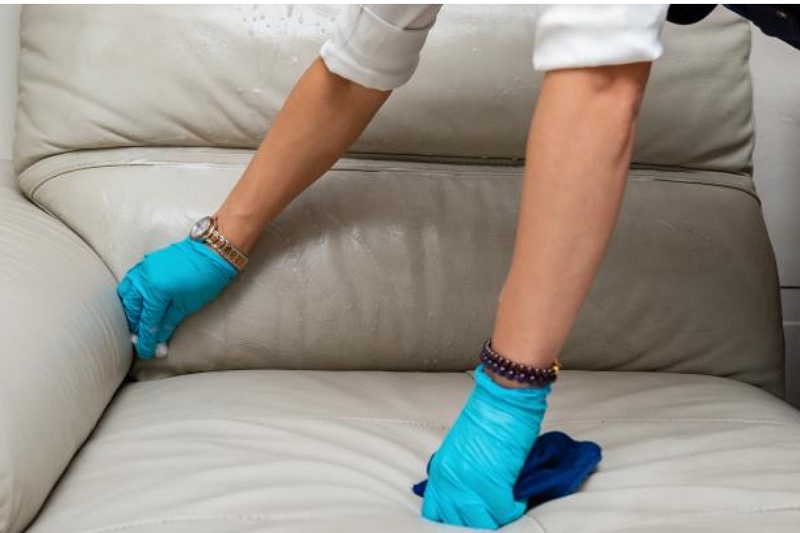Have you ever walked into someone’s home and noticed that there was an unpleasant smell? It could be a smoky odor, the musky scent of leather, or even something as simple as old cooking oil. However the smell originated, we can all agree it is not pleasant.
That being said, dealing with these types of smells in your own home can sometimes feel like a daunting task – but don’t worry! This article will provide 10 tips for preventing and eliminating leather chair odors so that your recliner looks great while smelling good too!

Tips for Preventing and Eliminating Leather Chair Odors
Tip 1. Use a humidifier to add moisture to your home. Dry air can contribute to that musty smell so even if you’re not adding humidity via an overhead fan, use a cool-mist humidifier instead of a hot water vaporizer in the bedroom or living room.
Tip 2. Open the windows and doors for at least 15 minutes each day during day. This will help to air out the room and dry off any wet furniture.
Tip 3. Place a bowl of white vinegar in your home’s largest central area such as an open floor plan living space, dining room, or kitchen for one week. The vinegar will absorb odors from cooking, pets, and some cleaners (but not all).
Tip 4. Place an open box of baking soda in your home’s largest central area such as an open floor plan living space, dining room, or kitchen for one week. The baking soda will absorb odors from cooking and pets.
Tip 5. Vacuum leather furniture regularly to remove pet hair and other debris that can cause odor problems. If you have a couch or other furniture that is cloth-covered, vacuum the fabric.
Tip 6. Vacuum your carpet and upholstery to remove pet hair and dirt particles from deep within the fibers. These can contaminate and hold onto odors in a way that’s difficult for vacuuming alone to address.
Tip 7. Wash any visibly soiled areas with mild soap and water or a leather-cleaning product.
Tip 8. Protect your furniture with a professional-grade leather conditioner to keep it supple and fresh smelling.
Tip 9. Treat any spills as soon as possible by blotting the area (don’t rub) with paper towels soaked in detergent before cleaning with mild soap and warm water mixture. Rinse and dry.
Tip 10. Avoid spilling, or if you do, wipe up the spill as quickly as possible with a damp cloth to avoid staining the leather fibers
Tip 11. Remove any stains by using an enzyme product designed for your type of leather furniture (e.g., Iverx Leather Cleaner). Follow all instructions carefully.
Tip 12. Replace the furniture’s felt or foam chair cushions with a hypoallergenic, anti-bacterial pillow. Visit this link for more information: (link to article page)
Tip 13. Repair any tears in the fabric as soon as possible by using leather glue or stitching it back together and reinforcing seams with heavy-duty thread.
Tip 14. Place a small, non-slip rug on the floor under your chair to reduce any potential slipping. If you are not going to use it for an extended period of time, protect your furniture with high-quality leather care products or store it in a place that is protected from dirt and dust. For example: storing inside an ab duffel bag or using a slipcover.
Tip 15. Keep the chair dry by wiping any spills right away. Use high-quality leather cleaning products to keep your furniture looking new!
Tips for preventing and eliminating mildew and mold
Number 1. Clean with a mixture of hydrogen peroxide and water.
Number 2. Hang up the chair to dry as quickly as possible.
Number 3. Use dehumidifiers or air conditioners in humid climates, especially during the summer months.
How to Clean a Recliner
Always clean your furniture according to the manufacturer’s instructions.
Cleaning leather chairs may be a bit more difficult than other types of upholstery due to their construction.
Use quality cleaners and conditioners that are made specifically for use on leather. Avoid using household products, such as soap or detergents; these will only dry out the leather and make it brittle over time.
Always follow the manufacturer’s instructions for use on your specific brand of furniture.
If you are using a cleaner, always remove any dirt or stains with rubbing alcohol before applying the product to clean. Some cleaners may be diluted according to package directions; however, if in doubt, always dilute according to package directions.
Do not apply cleaners or conditioners directly onto the leather; instead, spray on a small amount of water and then use a clean cloth to wipe it off.
Always dry your furniture after cleaning with a soft towel or dryer sheet before applying any type of surface protector such as a rug protector.
Use a high-quality leather protector such as Lexol, which is guaranteed to protect your furniture from spills and stains for years.
Avoid placing candles near the surface of your leather; if you do, never leave them unattended.
Keep coffee or tea on a coaster that’s been paired with an absorbent mat to reduce the amount of heat and moisture they leave behind.
Dust often with a soft brush or microfiber cloth. This will also help remove any dust particle buildup that may be irritating your skin.
Use an iron on a low setting, such as linen (or cotton) for drying if you are using water to dry.
